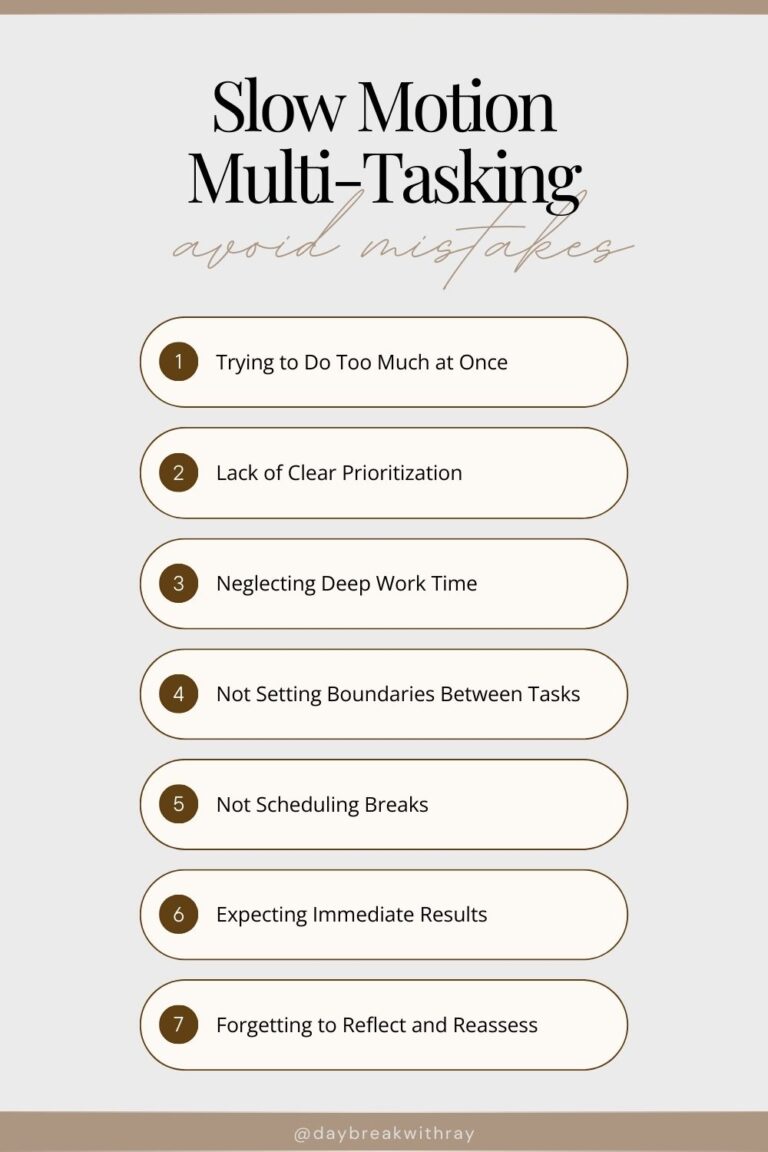7 Common Mistakes to Avoid for Slow Motion Multi-Tasking

Slow motion multitasking can be a game-changer for creativity and productivity, but it can also lower your efficiency and even lead to burnout if implemented wrongly. In this post, we’ll discover the benefits of Slow Motion Multi-Tasking as well as the 7 most common mistakes that you should avoid when it comes to this approach.
The Benefits of Slow Motion Multi-Tasking
Adopting slow motion multi-tasking as a productivity method offers significant advantages, from fostering creativity to reducing stress. Let’s explore the key benefits:
Working on diverse projects allows your brain to draw connections between different ideas, leading to innovative solutions. Tackling a mix of creative and logical tasks keeps your mind fresh and engaged.
For example, insights from one task may inspire breakthroughs in another.
Alternating between tasks in a structured way strengthens your ability to concentrate and manage your attention span. Regularly practicing slow motion multi-tasking hones your ability to focus deeply when needed.
For example, scheduling intentional focus periods for each project builds discipline and efficiency.
Slow motion multi-tasking avoids the chaos of traditional multitasking by allowing you to focus on one task at a time, without feeling rushed. A clear plan reduces the mental clutter associated with juggling multiple priorities.
For example, you can allocate time for each project without the guilt of neglecting others.
You no longer have to choose between projects; instead, you can make steady progress in different areas of your life. This method supports holistic development by balancing diverse priorities.
For example, you can advance your career, hobbies, and personal growth simultaneously.
Managing various tasks teaches adaptability and the ability to pivot between projects as circumstances change. The skill of shifting focus without losing momentum prepares you for challenges and unexpected changes.

7 Common Mistakes to Avoid
While slow motion multi-tasking can be an incredibly effective strategy, it’s easy to slip into habits that undermine its benefits. Here are some pitfalls to watch out for and how to avoid them:

Mistake No. 1
Trying to Do Too Much at Once
Slow motion multi-tasking isn’t about juggling countless tasks simultaneously—it’s about strategically alternating focus. Limit yourself to 2-3 key projects at a time. Ensure each task aligns with your priorities and goals.

Mistake No. 2
Lack of Clear Prioritization
Without a clear understanding of which tasks need your attention first, you risk spending time on less important projects. Use tools like Eisenhower Matrix or to-do lists to rank your tasks by urgency and importance.
Tip: Tackle high-priority tasks in the morning when your energy is highest.
Mistake No. 3
Neglecting Deep Work Time
Constantly switching tasks without committing deep focus to any one project reduces overall productivity and quality. Instead, dedicate uninterrupted blocks of time to specific tasks before transitioning to the next.
Tip: Set a timer for 45 minutes to fully focus on one project, then take a short break before moving on.

Mistake No. 4
Not Setting Boundaries Between Tasks
Blurring the lines between tasks can lead to confusion and inefficiency, leaving you feeling scattered. What you can do is to physically or mentally separate tasks.
For example, close unrelated browser tabs or create distinct environments for different types of work.
Tip: Use a separate workspace for creative tasks versus administrative work.
Mistake No. 5
Not Scheduling Breaks
Continuous task-switching without downtime leads to mental fatigue and burnout. Try to schedule intentional breaks between tasks to recharge your energy and creativity.
Tip: Use techniques like the Pomodoro method to balance focus and rest.

Mistake No. 6
Expecting Immediate Results
Slow motion multi-tasking is about long-term progress, not quick wins. Impatience can derail your efforts. Track small milestones and celebrate incremental progress to stay motivated.
Mistake No. 7
Forgetting to Reflect and Reassess
Without regular reviews, it’s easy to lose sight of your progress and priorities, potentially wasting time on tasks that no longer matter. Set weekly or monthly check-ins to evaluate whether your projects are aligned with your overarching goals.
Tip: At the end of each week, ask yourself, “Is this task still worth my time?”

Conclusion
Whether you’re tackling creative projects, professional goals, or personal ambitions, this strategy helps you prioritize effectively while staying adaptable. By avoiding common mistakes and using the right tools, slow motion multi-tasking can become a cornerstone of your success.
I'm not flexible and I certainly don't have a lot of free time. But that's no excuse to stop myself
Mistakes happen but what will you do about it? Beat yourself up or take this opportunity to learn th
Looking for different self-care activities to enjoy? Try these 5 Japanese-Style wellness activities



